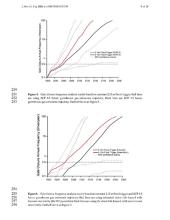
About this project
Storm surge barriers or tide gates can minimize flooding and protect people and property during large storms. Yet their environmental effects are poorly understood and feasibility studies of potential surge barriers need to consider a range of potential impacts on an estuary. To broaden understanding of surge barriers being considered for the New York-New Jersey harbor, a 2018 catalyst project modeled and analyzed barriers' physical effects and hosted a series of workshops to synthesize and share information.
About these datasets
The research team conducted a series of analyses to understand how a hypothetical surge barrier might operate and impact the Hudson River estuary under different future sea level rise scenarios. The team used historical observations to represent future storm tide hazard, and then superimposed local relative sea level rise to study the potential future changes to closure frequency and duration. In addition, the team considered how a closed surge barrier would trap river streamflow and lead to river flooding using historical data and an existing hydrodynamic model.
The analyses are based on preexisting NOAA and USGS observational data, including historical storm tide data from 1920 to 2019. Both the statistical model code (in python) and the results are being made available for the following analyses:
- Surge barrier closure frequency and closure duration under different sea level rise scenarios
- Trapped river water levels under different barrier management and sea level rise scenarios
Geographic extent: The Hudson River estuary, NY
Time period: Analysis results are based on data from 1920 to 2009
Data file format: Statistical modeling was conducted in Python. Results are available as csv files.
Data access: Python code and datasets are part of the supplemental material for an open-access article (see below) and are also available at the project webpage.
Code, data, and results are featured in this paper: Chen, Z., P. M. Orton, and T. Wahl. 2020. Storm Surge Barrier Protection in an Era of Accelerating Sea Level Rise: Quantifying Closure Frequency, Duration and Trapped River Flooding, Journal of Marine Science and Engineering 8(9):725. Available at: https://doi.org/10.3390/jmse8090725
For questions about these datasets, contact:
Philip Orton, Stevens Institute of Technology, [email protected]